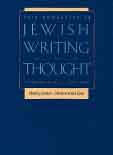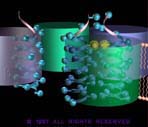The University of Chicago Magazine
October 1997

Citations
German and Jewish
From early Yiddish literature through the work
of Heinrich Heine, Sigmund Freud, and Franz Kafka, the Yale Companion to
Jewish Writing and Thought in German Culture, 10961996 (Yale)-edited
by Jack Zipes of the University of  Minnesota
and Sander L. Gilman, a U of C professor of the liberal arts in human biology,
Germanic studies, comparative literature, the Committee on Jewish Studies,
and psychiatry-chronicles nine centuries of the German-Jewish intellectual
and cultural experience. Examining political and social events, cultural
debates, and literary movements, as well as German-Jewish writers themselves,
the book's 119 contributors explore the uniqueness of the Jewish contribution
to German thought and ask what it means to be the "other" within
mainstream German culture. Discussing themes of exile, achievement, identity,
and the relationships between cultures, the essays analyze everything from
Renaissance Jewish mysticism to West Germany's 1979 broadcast of the American
television series Holocaust.
Minnesota
and Sander L. Gilman, a U of C professor of the liberal arts in human biology,
Germanic studies, comparative literature, the Committee on Jewish Studies,
and psychiatry-chronicles nine centuries of the German-Jewish intellectual
and cultural experience. Examining political and social events, cultural
debates, and literary movements, as well as German-Jewish writers themselves,
the book's 119 contributors explore the uniqueness of the Jewish contribution
to German thought and ask what it means to be the "other" within
mainstream German culture. Discussing themes of exile, achievement, identity,
and the relationships between cultures, the essays analyze everything from
Renaissance Jewish mysticism to West Germany's 1979 broadcast of the American
television series Holocaust.
Calculation Reevaluation
Just what is the size of the federal deficit? Not as great as it seems, according to U of C economist Thomas Sargent, who says the amount consists mostly of interest costs on the federal government's borrowing, and those costs are overstated by the U.S. Treasury. In the July/August issue of Economic Perspectives, published by the Federal Reserve Bank of Chicago, Sargent-who consults for the bank-and George J. Hall, an economist at the bank, write that the official calculations ignore "the effects of inflation and changes in interest rates on the value of the outstanding federal obligations." And they note: "Compared with the official numbers, the true figures are much more variable, and lower on average."
Comfortably Numb
Though doctors have used anesthesia for 155
years, they did so without understanding how it numbs pain. But with recent
research that could help in designing new medications and provide insight
into the genetics of alcoholism, scientists from the U of C Medical Center,
the University of Colorado at Denver, and the University of Pennsylvania
are beginning to understand  anesthesia's
effects on the brain. Their study, published in Nature, shows that both
alcohol and anesthetics increase the effects of the neurotransmitter GABA,
which prevents nerve cells from sending sensory information to the brain
and causes the unconsciousness and amnesia associated with anesthetics.
The re-searchers are now developing mice with mutant GABA receptors to verify
that the effects of alcohol and anesthesia change when the receptors are
altered. Says study director Neil Harrison, a U of C associate professor
of anesthesia and critical care, "This allows us to begin the process
of designing and synthesizing new anesthetics based on where and how they
work, rather than on serendipity and sheer dumb luck."
anesthesia's
effects on the brain. Their study, published in Nature, shows that both
alcohol and anesthetics increase the effects of the neurotransmitter GABA,
which prevents nerve cells from sending sensory information to the brain
and causes the unconsciousness and amnesia associated with anesthetics.
The re-searchers are now developing mice with mutant GABA receptors to verify
that the effects of alcohol and anesthesia change when the receptors are
altered. Says study director Neil Harrison, a U of C associate professor
of anesthesia and critical care, "This allows us to begin the process
of designing and synthesizing new anesthetics based on where and how they
work, rather than on serendipity and sheer dumb luck."
Baby Birds and Bees
Puberty may actually start at age 6, according to U of C psychologists Martha McClintock and Gilbert Herdt. The two say that the hormones responsible for initiating puberty come not from the testes and ovaries, but rather from the adrenal glands, which are usually associated with stress hormones. In the journal Current Directions in Psychological Science, McClintock and Herdt write that the body's levels of the adrenal androgen DHEA begin increasing at age 6, reach a critical level at 10, and arrive at adult levels at 18. That corresponds with their idea of sexuality as a developmental process: Initially, the androgen seems to cause changes in complexion and a growth spurt, while sexual attraction first appears at 9 and 10, turning into desire two years later, and action another two years after that.
Also in Investigations:
Oriental Institute researchers Tony Wilkinson and McGuire Gibson, AM'64, PhD'68, uncover ancient Arabia.
